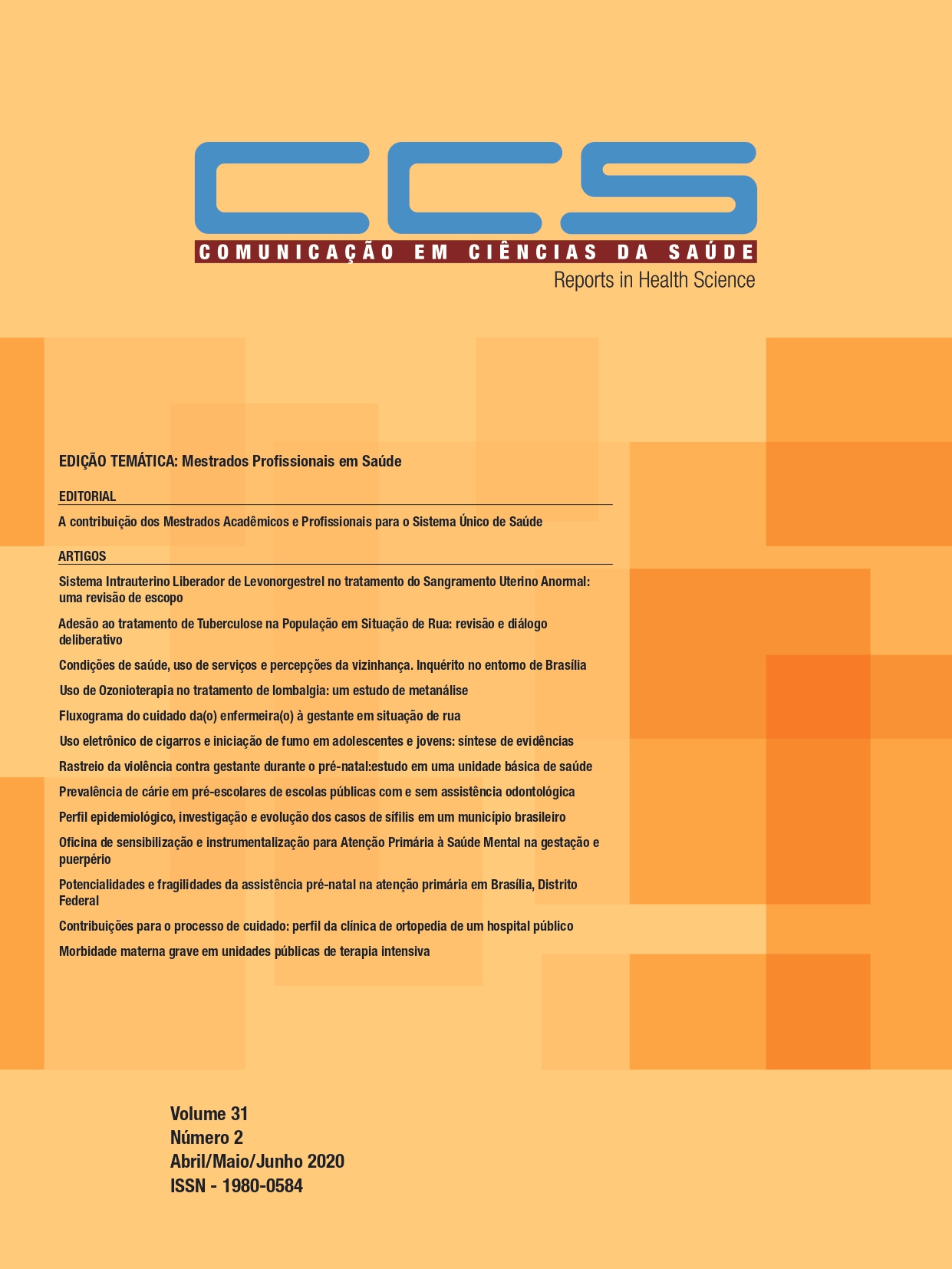Reasons for the use of levonogestrel - releasing Intrauterine System (IUS) in the treatment of women with abnormal uterine bleeding in SUS
DOI:
https://doi.org/10.51723/ccs.v31i02.573Keywords:
Dispositivos intrauterinos, Menorragia, Sangramento uterino disfuncional.Abstract
Abnormal uterine bleeding (SUA) is a syndrome characterized by changes in woman's menstrual pattern that negatively influences her quality of life. The causes range from uterine structural diseases (polyps, fibroids, adenomyosis, malignancies) to functional disorders (coagulation disorders, ovulation), with about 20% of cases without a clear factor. The treatment has the purpose to make the uterine bleeding tolerable and the pharmacological treatment through oral and injectable medicines, as well as through subdermal implants or intrauterine devices. In case of failure of the above, hysterectomy or endometrial ablation are options. Levonorgestrel-releasing intrauterine system - SIU-LNG is a non-invasive, cost-effective treatment with a positive impact on quality of life. To evaluate it, a literature review was performed in the PUBMED, Cochrane and Lilacs databases, from articles published until June 2019 focusing on SIU-LNG as the one of the interventions in the treatment of SUA. It was observed that this is a therapeutic option even considered as the first line of treatment in some countries, precisely because of its cost-effectiveness, reversibility (for women without defined offspring) and good control of SUA. In Brazil, this device is not available in the public health system, preventing that some women could benefit from its use. The evidences presented herein are expected to help change this reality and significantly reduce the number of women that has been submitted to unnecessary surgical treatments.
Downloads
References
Freitas F. Rotinas em Ginecologia. 6ª ed ed. Porto Alegre: Artmed Editora; 2011.
Shaw V, Vandal AC, Coomarasamy C, Ekeroma AJ. The effectiveness of the levonorgestrel intrauterine system in obese women with heavy menstrual bleeding. The Australian & New Zealand journal of obstetrics & gynaecology. 2016;56(6):619-23. http://doi.org/10.1111/ajo.12528
Lethaby A, Wise MR, Weterings MA, Bofill Rodriguez M, Brown J. Combined hormonal contraceptives for heavy menstrual bleeding. The Cochrane database of systematic reviews. 2019;2. https://doi.org/10.1002/14651858.cd000154.pub3
Gupta JK, Daniels JP, Middleton LJ, Pattison HM, Prileszky G, Roberts TE, et al. A randomised controlled trial of the clinical effectiveness and cost-effectiveness of the levonorgestrel-releasing intrauterine system in primary care against standard treatment for menorrhagia: the ECLIPSE trial. Health technology assessment (Winchester, England). 2015;19(88):i-xxv, 1-118. https://doi.org/10.3310/hta19880
Chen Y-J, Li Y-T, Huang B-S, Yen M-S, Sheu B-C, Chow S-N, et al. Medical treatment for heavy menstrual bleeding. Taiwanese Journal of Obstetrics and Gynecology. 2015;54(5):483-8. https://doi.org/10.1016/j.tjog.2015.08.001
Davidson BR, DiPiero CM, Govoni KD, Littleton SS, Neal JL. Abnormal uterine bleeding during the reproductive years. Journal of Midwifery & Women’s Health. 2012;57(3):248-54. htts://doi.org/10.1111/j.1542-2011.2012.00178.x
Bradley LD, Gueye N-A. The medical management of abnormal uterine bleeding inreproductive-aged women. American journal of Obstetrics and Gynecology. 2016;214(1):31 44. https://doi.org/10.1016/j.ajog.2015.07.044
Magnay JL, O'Brien S, Gerlinger C, Seitz C. A systematic review of methods to measure menstrual blood loss. 2018;18(1):142. https://doi.org/10.1186/s12905-018-0627-8
Davies J, Kadir RA. Heavy menstrual bleeding: An update on management. Thrombosis research. 2017;151 Suppl 1:S70-s7. https://doi.org/10.1016/S0049-3848(17)30072-5
Health Quality Ontario. Levonorgestrel-Releasing Intrauterine System (52 mg) for Idiopathic Heavy Menstrual Bleeding: A Health Technology Assessment. Ont Health Technol Assess Ser. 2016;16(18):1-119. Acessado em: <https://www.ncbi.nlm.nih.gov/pmc/articles/PMC5159479/>
Geary RS, Gurol-Urganci I, Kiran A, Cromwell DA, Bansi-Matharu L, Shakespeare J, et al. Factors associated with receiving surgical treatment for menorrhagia in England and Wales: findings from a cohort study of the National Heavy Menstrual Bleeding Audit. BMJ Open. 2019;9(2):e024260. http://dx.doi.org/10.1136/bmjopen-2018-024260
NICE guidance. Heavy menstrual bleeding: assessment and management. 2018 10 ago. 2019. Acessado em: < https://www.nice.org.uk/guidance/ng88/resources/heavy-menstrual-bleeding-assessment-and-management-pdf-1837701412549>
Hubacher D. The levonorgestrel intrauterine system: reasons to expand access to the public sector of Africa. Global Health: Science and Practice. 2015;3(4):532-7. https://doi.org/10.9745/GHSP-D-15-00178
Sergison JE, Maldonado LY, Gao X, Hubacher D. Levonorgestrel intrauterine system associated amenorrhea: a systematic review and metaanalysis. Am J Obstet Gynecol. 2019;220(5):440-8.e8. https://doi.org/10.1016/j.ajog.2018.12.008
Eva G, Nanda G, Rademacher K, Mackay A, Negedu O, Taiwo A, et al. Experiences With the Levonorgestrel Intrauterine System Among Clients, Providers, and Key Opinion Leaders: A Mixed-Methods Study in Nigeria. Global health, science and practice. 2018;6(4):680-92. https://doi.org/10.9745/GHSP-D-18-00242
van den Brink MJ, Beelen P, Herman MC, Claassen NJJ, Bongers MY, Geomini PM, et al. Women's preferences for the levonorgestrel intrauterine system versus endometrial ablation for heavy menstrual bleeding. European journal of obstetrics, gynecology, and reproductive biology. 2018;228:143-7. https://doi.org/10.1016/j.ejogrb.2018.06.020
Lethaby A, Hussain M, Rishworth JR, Rees MC. Progesterone or progestogen‐releasing intrauterine systems for heavy menstrual bleeding. Cochrane Database of Systematic Reviews. 2015(4). https://doi.org/10.1002/14651858.CD002126.pub3
Marjoribanks J, Lethaby A, Farquhar C. Surgery versus medical therapy for heavy menstrual bleeding. Cochrane Database of Systematic Reviews. 2016(1). https://doi.org/10.1002/14651858.CD003855.pub2
van Dongen H, van de Merwe AG, de Kroon CD, Jansen FW. The impact of alternative treatment for abnormal uterine bleeding on hysterectomy rates in a tertiary referral center. Journal of minimally invasive gynecology. 2009;16(1):47-51. https://doi.org/10.1016/j.jmig.2008.09.608
Adiguzel C, Seyfettinoglu S, Aka Satar D, Arlier S, Eskimez E, Kaya F, et al. Evaluation of quality of life and cost-effectiveness of definitive surgery and the levonorgestrel intrauterine system as treatment options for heavy menstrual bleeding. Turkish journal of medical sciences. 2017;47(3):789-94. https://doi.org/10.3906/sag-1512-115
Sesti F, Piancatelli R, Pietropolli A, Ruggeri V, Piccione E. Levonorgestrel-releasing intrauterine system versus laparoscopic supracervical hysterectomy for the treatment of heavy menstrual bleeding: a randomized study. Journal of Women's Health. 2012;21(8):851-7. https://doi.org/10.1089/jwh.2011.3261
Lete I, Cristóbal I, Febrer L, Crespo C, Arbat A, Hernández F, et al. Economic evaluation of the levonorgestrel-releasing intrauterine system for the treatment of dysfunctional uterine bleeding in Spain. European Journal of Obstetrics & Gynecology and Reproductive Biology. 2011;154(1):71-80. https://doi.org/10.1016/j.ejogrb.2010.08.019
Blumenthal PD, Dawson L, Hurskainen R. Cost-effectiveness and quality of life associated with heavy menstrual bleeding among women using the levonorgestrel-releasing intrauterine system. International Journal of Gynecology & Obstetrics. 2011;112(3):171-8. https://doi.org/10.1016/j.ijgo.2010.08.025
Bahamondes MV, de Lima Y, Teich V, Bahamondes L, Monteiro I. Resources and procedures in the treatment of heavy menstrual bleeding with the levonorgestrel-releasing intrauterine system (LNG-IUS) or hysterectomy in Brazil. Contraception. 2012;86(3):244-50. https://doi.org/10.1016/j.contraception.2011.12.005
Teich V, Bahamondes MV, Lima Y, Santoni NB, Bahamondes L, Monteiro I, et al. Uso de recursos e custos associados ao tratamento da menorragia idiopática com o sistema intra-uterino liberador de levonorgestrel (SIU-LNG) versus histerectomia: perspectiva do Sistema Único de Saúde (SUS). J Bras Econ Saúde. 2012;4(2):373-81. Acessado em: < http://www.jbes.com.br/images/v4n2/art02.pdf>
Silva Filho ALd, Rocha ALL, Pereira FdAN, Tavares RL, Ferreira MCF, Lamaita RM, et al. Tratamento do sangramento uterino anormal: uma análise sob a perspectiva dos custos no Sistema Único de Saúde e da medicina suplementar. Reprodução & Climatério. 2016;31(1):31-6. https://doi.org/10.1016/j.recli.2016.01.003
Additional Files
Published
Versions
- 2020-10-26 (3)
- 2020-10-05 (2)
- 2020-10-02 (1)
Issue
Section
License
Declaro para os devidos fins que o artigo que estou submetendo representa um trabalho original e nunca foi publicado total ou parcialmente, e que se alguma de suas partes foi publicada possuímos autorização expressa para a publicação no periódico Comunicação em Ciências da Saúde (CCS). Esse artigo não foi enviado a outro periódico e não o será enquanto estiver sendo considerada sua publicação; caso venha a ser aceito não será publicado em outro periódico; e não contém material difamatório ou ilegal sob nenhuma forma, não viola a intimidade de terceiros, nem infringe direitos protegidos.
Eu e demais autores desse trabalho certificamos por meio desta declaração que:
- Concordamos com as normas editoriais e com o processo de revisão da CCS;
- Aceitamos a responsabilidade pela conduta desse estudo e pela análise e interpretação dos dados;
- Cooperaremos, sempre que solicitado, na obtenção e fornecimento de dados sobre os quais o manuscrito está baseado, para exame dos avaliadores;
- Não estão sendo omitidos quaisquer ligações ou acordos de financiamento entre os autores e companhias ou pessoas que possam ter interesse no material abordado no artigo;
- Não estão sendo excluídos ou omitidos deste artigo autores ou instituições participantes;
- Possuímos permissão para uso de figuras e tabelas publicadas em outras fontes;
- Possuímos permissão das pessoas e instituições citadas nos agradecimentos;
- O autor correspondente autoriza a publicação do endereço informado e e-mail do(s) autor(es) junto com o artigo;
- Assumimos a responsabilidade pela entrega de documentos verídicos;
- Autorizamos a publicação do referido artigo no periódico Comunicação em Ciências da Saúde, segundo critérios próprios e em número e volume a serem definidos pelo editor do periódico;
- Nos comprometemos a atender os prazos estipulados pelos editores do periódico Comunicação em Ciências da saúde;
- Estamos cientes de que a não manifestação no prazo de dois dias da revisão da diagramação, recebida por e-mail, será considerado aprovado para publicação.








